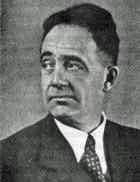
1890-1943
Heinrich Zimmer Jr. was influenced by the writings of John Woodroff and C.G. Jung in his interpretations of Indian myths and legends. He also studied philosophy and yoga.
Heinrich Zimmer was born in Greifswald on 6.12.1890. His father, Heinrich Friedrich Zimmer (1851- 1910) was a professor of Indology and comparative linguistics.
Heinrich Zimmer Jr. studied Hebrew literature, German philology and history of art in Berlin. Later, he devoted himself exclusively to Indology. He obtained a doctorate in 1913 for the thesis Studien zur Geschichte der Gotras ("Studies on the History of the Gotras"), 1913. He served in World War I. He qualified as a university professor in Greifswald with a thesis on a Buddhist text found in Central Asia. In 1922 he became reader in Heidelberg. The Nazis dismissed Zimmer in 1939 because of his Jewish wife. He went to Oxford where he lectured at Balliol College. In May 1940, he emigrated to America with his family. He lectured at the Johns Hopkins University in Baltimore before he became a visiting professor in Columbia University, New York. He died of pneumonia on 20.3.1943 in New Rochelle, New York.
Zimmer wrote Kunstform und Yoga ("Art and Yoga") in 1926. C.G. Jung was impressed by this treatise since it was the first study of mandalas. (Zimmer and C.G. Jung met for the first time in 1932). Ewiges Indien, Leitmotive indischen Daseins ("Eternal India, leit motifs of Indian Being") followed in 1930. Indische Sphaeren appeared in 1935, second edition, Zuerich, 1963. This book contained four essays.'In the first essay Indischer Mythos ("Indian Myth") Zimmer said that Vedic myths were developed in a particular society and centered around gods, saints and princes. Creation was the function of a male god, Prajapati. In the "other India", as he called the pre-Aryan people, myths were about mountains, rivers and holy places. The marriage of Shiva and Parvati was symbol of the entwining of the two strands in Indian culture. Mythology's task was to blend them into one - Hinduism. The second essay was Der Brauch der Fische ("The Custom of Fish"). It was a treatise on statecraft which primarily dealt with material gain. The longest essay was the third, Yoga and Maya. In Zimmer's opinion, only the freedom of the spirit was known in the West. In India there were as many freedoms as methods of Yoga. He discussed Jain Yoga, the Yoga of the Bhagavadgita and Buddhist Yoga. He described postures (asanas) breathing exercises and the Kunddlini. Although Zimmer recognised the value of Yoga, he doubted whether Yoga would benefit Westerners. In the fourth essay, "Buddha", Zimmer discussed the four noble truths.
Maya, der indische Mythos ("Maya, Indian myth"), and Weisheit Indiens, Maerchen und Sinnbilder ("Wisdom of India, Tales and Symbols"), 1938, followed. In these works Zimmer attempted to explain Indian religious, social and cultural phenomena by comparing them with Western ideas. Zimmer's last book was written in German and published after his death by C.G. Jung. It was entitled Der Weg zum Selbst ("The Path to Self"). This book deals with the life and teachings of Ramana Maharshi of Tiruvan-namalai.
Other papers were Die Rolle des Yoga in der indischen Geistesgeschichte ("On the importance of Yoga in Indian culture"), Deutsche Vierteljahres-schrift, 1926; Der Koenig in der dunklen Kammer ("The King in the Dark Chamber"), Journal of the German Oriental Society, 1929 and "Some Aspects of Time in Indian Art" in Journal of the Indian Society of Indian Art, 1933. He contributed Die Inder bis zum Einbruch des Islam ("The Indians up to the advent of Islam") to the History of the World, Neue Propylaeen Weltgeschichte, 1940.
Zimmer translated a number of texts, e.g., the Ashtavakragita and the Matangalila also Buddhist legends from the Divyavadana.
Zimmer published his Baltimore lecture Hindu Medicine, 1940. His student John Campbell edited "Myths and Symbols in Indian Art and Civilization", 1946, and "The King and the Corpse: Tales of the Soul's Conquest of Evil." He discussed not only Indian myths but also the traditions of many other nations ranging from the tales of "A Thousand and One Nights" to the legends of King Arthur.
"Philosophies of India" was published in the Bollington Series, by John Cambell after Zimmer's death. The edition is based on Zimmer's notes of his lectures delivered at Columbia University. The chapters "The Meeting between East and West", "The Foundations of Indian Philosophy" and "The Philosophy of Time" divided into three parts artha, kama, and dharma were complete. The chapters on Jainism, Samkhya, Yoga, Brahmanism, Buddhism and Tantra were not complete. The chapter on Tantra was particularly fragmentary.
Zimmer's monumental The Art of Indian Asia, Its Mythology and Transformation was published in 1955 after his death. Volume I contains the text, volume II the illustrations. The editor, John Campbell, stated that this work was intended not as a handbook but an introduction to the subject. Zimmer's first chapter was devoted to the great periods of Indian art. He next discussed the Indus Valley Civilization and the Vedic Aryan style. This short chapter was devoted to the Vedic sacrifice. The illustrations showed present day sacrificial implements "which have about them the quality of stone age.“ Zimmer was of the opinion that the mounts of Indian gods and goddesses were derived from Mesopotamian deities shown standing on animals. Chapters on the Indian ideal of beauty and the symbolism followed. The book concluded with chapters on Indian architecture and sculpture and an appendix on the art of painting.